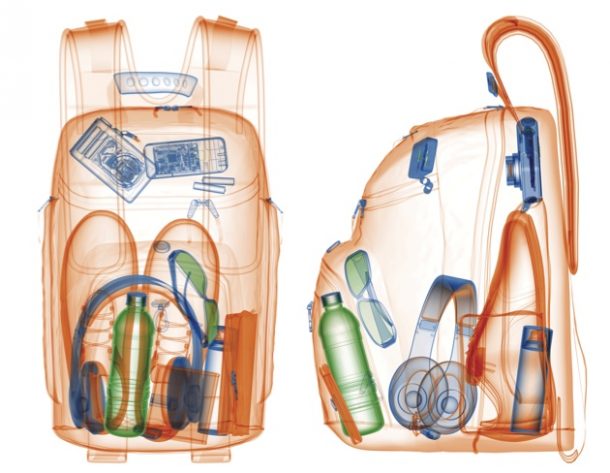With millions of people traveling during the holidays, it’s a busy time for any airport. Long lines, delays, and pushing your carry-on into a scanner are all things you’ve probably encountered these past few months if you’ve traveled by plane. As you entered the body scanner and raised your hands above your head while placing your feet on the footprint markers below you, you might have wondered, “What kind of technology is being used to scan my luggage, and more importantly, my body?”

Image source: Airport Guys.
First, know that the two types of scanners used in airports include millimeter radio-wave and backscatter scanners, according to radiologyinfo.org. Millimeter radio-wave scanners use millimeter radio waves similar to those generated by cell phones. This type of scanner does not use X-rays. The second type, backscatter scanner, uses low-intensity X-rays.
In most X-ray scanners, two sources are used: one is suspended on the top whereas the other stays at the side. This is so that there are two different points of view of the same package, which can help identify an object that may be blocked from one side and efforts to hide any contraband are eliminated.
Typical X-ray systems you’ll find at an airport provide two levels of X-ray intensity. The two-level, two-plane X-ray combined with a central sensor provides more information about package content than any conventional X-ray system. The information is sent to the computer it’s connected to, which identifies the contents using identification algorithms. The algorithms calculate the Z effective number (the number of protons in a nucleus) and mass density of the objects in the bag. Some objects have identical Z effective numbers and mass density values individually, but when combined, the identity of an unknown substance is evident.
The X-rays launched from one side of the machine are identified by a pair of detectors on the opposite side. When your bag enters through the lead-lined curtains, the objects absorb some of the X-ray energy, meaning that the X-rays that pass through your luggage have less energy than those of the others.

Image source: YouTube.
Then, the X-rays hit plate-like detectors on the other side, where their energy and position is recorded. Next, a filter is added on their way to the second detector, which blocks low-energy X-rays, meaning that the second detector only detects high-energy X-rays. By comparing the two outputs, the machine constructs an image showing the position of objects and their density.
When an illegal material is identified by the computer algorithms, technologies such as IBS/Scantech serve as a recheck by showing the carbon outline in both views. The operator can then use the Z effective number and mass density to accurately characterize the material, reducing false alarms while increasing control and safety.
It’s this technology that differentiates flour from cocaine, talcum powder from explosive ones, and regular plastic from a bomb casing. Most of the conventional systems include threat image projection for training and performance enhancement, along with the capability of magnifying the images, creating 3D views, and color-coding. For example, organic materials such as paper, food, and explosives are orange, while blue or green colors represent metals and glass. Basically, the denser the material, the darker its color appears.
Source: Wonderful Engineering
Advertisement
Learn more about Electronic Products Magazine





